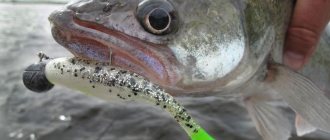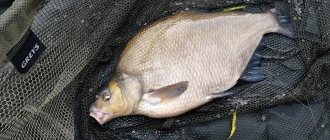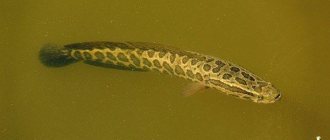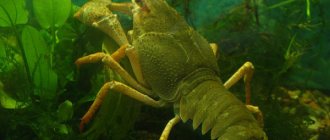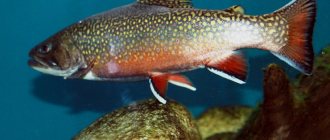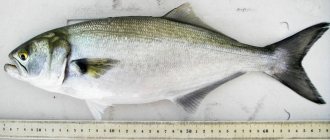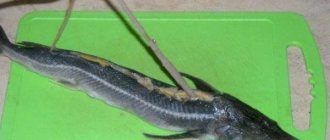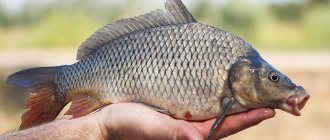Sterlet – where to look and what to catch in 2021
Sterlet prefers exclusively clean water bodies, so near cities where enterprises discharge into the river, you definitely won’t find sterlet, so to catch it you need to go far down the river.
Sterlet prefers places where there is a fast current and a depth of at least 10 m. In places with standing water you will only waste time, since the sterlet avoids such places. It mainly lives in river mouths, places with rapids, so you need to catch it there - look for sterlet, where there is noise, movement and cold water. Below you will find specific places where sterlet lives (On the Volga, Vyatka, Irtysh, Ob, Oka), learn about different methods of fishing (donka, rubber band), details about gear and bait and features of winter fishing.
Donka for sterlet photo, catching sterlet: where and what to catch. tackles and methods of catching sterlet
To make money, the sterlet explores areas bordering on standing water. In such places, insect larvae, insects and worms escaping from the current settle. You should not look for sterlet in areas where there is no current, as it prefers to stick to areas with current. When visiting the boundaries of fast currents and standing water, the sterlet still adheres to this boundary and does not enter the area of standing water. The sterlet emerges from the pits only in the mornings, and in the evening it returns to the depths again. When going out onto the shallows, she chooses areas located 40 meters from the shore, or even more. This is provided that there is an optimal amount of water in the reservoir.
Sterlet prefers to stay in flocks, therefore, having caught one individual, you can safely count on a series of bites. At the same time, you need to very quickly return the bait to the catchable place, otherwise it can quickly leave this place. If a sterlet finds bait lying on the bottom, it will certainly want to swallow it.
They begin to catch sterlet in early spring, and its fishing ends in late autumn. And short leashes with a length of 10 cm are fixed on the main fishing line. Hooks made of wrought iron or wire are attached to them. Self-catchers are installed against the current mainly in winter or autumn, in deep places in the reservoir. After a fish hits one of the traps, the others are transferred closer to it. The bait for catching sterlet is maggots or bloodworms. However, I would like to warn you that fishing for sterlet using aeroplanes is considered illegal, so fishing with such gear is not recommended. As you can see, catching sterlet is an interesting and exciting activity. But to avoid an unpleasant fishing experience, always remember the rules for catching fish such as sterlet. Today there are many ways to increase your catch. One of the interesting options is a bite activator. It attracts fish from long distances and stimulates its appetite with the help of pheromones that are included in the composition and influence the behavior of individuals. Pheromones are natural biologically active substances that are secreted by living organisms, including fish. When hunting for this fish, quite often you will catch pike perch, pike, bream, and white-eye on the hook. This is explained by the popularity of the packing material. However, if you find a fishing spot and use bottom gear, the angler can count on a good catch. Catching sterlet on a donk: The first fishing gear was created in the 1920s in England. Ten years later, bite alarms appeared, which became a sensitive extension of bottom gear.
Sterlet fishing: the best tackle, bait and lures
By the behavior of the alarms, fishermen began to judge the nature of the bite. Such steps led to the emergence of modern gear that is designed for bottom fishing for sterlet. It is important that during the development of such fishing, gear became more improved, which led to the prevention of entanglement when casting. Today, clever bottom equipment is popular among fishermen hunting for sterlet. Peculiarities of catching sterlet on a donk Since sturgeon aquatic inhabitants are at the stage of extinction, catching sterlet has a number of restrictions. Fishing can only be done with a license. And since there is at least some chance of catching this type of fish, it makes sense to talk about the peculiarities of fishing. Fishing with bottom gear begins in late spring, when the sterlet has spawned.
Among the effective methods of fishing, catching sterlet on a donk equipped with a rubber shock absorber stands out. When the water begins to warm up in early summer, the fish move closer to the shore in search of food. This is where you need to be patient after casting a donkey with a rubber band for fishing. At the height of the summer months, sterlet is not attracted to the shores of reservoirs; it moves to deeper areas. During this period, fishermen equip the donk with a heavier load. This allows you to cast the tackle over a long distance and hold it under fishing conditions in fast currents. When fishing with a spinning rod with bottom equipment, you need to choose a powerful rod that will not bend when fishing fish out of the water. The tackle is equipped with a leash of no more than 30 cm.
How to catch sterlet - basic nuances
The load is selected taking into account the fishing conditions - casting distance, current strength. As for bait and bait, sterlet prefers food of animal origin. In Russia, the capture of this inhabitant of the aquatic environment is allowed. You just need to buy a license that gives you the right to do this. Recently, experts have noted an increase in the population of this fish. But even despite this, a large specimen is rarely caught, using several types of gear. To catch sterlet, the law allows the use of the following fishing gear: The best bait for catching sterlet is a worm. The size of the worm in this case does not matter. Most anglers puncture the earthworm well to prevent it from breaking off. When fishing with a donk, there is no spooking of fish. It may seem to many that catching sterlet with a fishing rod is a very uninteresting process, but with this equipment you can catch a large number of fish. Since this fish is of a calm nature, fishing with a fishing rod takes place without any resistance. It is recommended to use float gear to catch fish near the banks after the flood has subsided. At this time, she begins active hunting near coastal areas. Activity occurs during the daytime, so this is the right time to use float gear. When the autumn cold sets in, the water in reservoirs begins to decrease. Catching a heavy sterlet is considered a great success. Most often you come across sterlets up to fifty centimeters long, which are caught using a simple donka with a fishing rod. You can take the cheapest reel and rod, since fish rarely come off the hook when fishing and offer almost no resistance. The fishing line is used with a diameter of 0.25 millimeters, and a sinker weighing from thirty to eighty grams. When choosing a sinker, it all depends on the current. In the warm season, fish mainly gather in the river bed and feed on bottom invertebrates. Therefore, you can take earthworms and red worms as bait. Sometimes a sterlet can catch on a hook with its belly, but when fishing it walks quite calmly. Many fishermen like to catch it on donks with rubber shock absorbers. This method is very catchy. With this method of catching sterlet, you should use bottom equipment. Its disadvantage is the extensibility and, as a result, low sensitivity of the gear. It is better to fish with a feeder with a cord, since it is equipped with modern high-quality rings that will not wear out the braid. The diameter of the fishing line is selected in the range of 0.30-0.35 mm. Due to its high strength, the cord can be taken thinner.
It is advisable to use a fluorocarbon leash. The fact is that sterlet fishing is often carried out on a pebble bottom or strewn with shell rock, so abrasive resistance is of great importance for successful fishing.
Usually a piece of 0.20-0.25 mm is tied. Its length ranges from 20-50 cm and depends on the mood of the fish.
- When to fish in Khabarovsk
- Pelican keelboat
- Work on a fishing vessel vacancies for women without work experience 2016
- Fishing for pike in March using a spinning rod
The hook is of medium size. It is rational to select it according to the bait, and not according to the probable weight of the sterlet. The best baits for this underwater representative are:. Maggot and worm can be combined by placing them on the hook at the same time. In winter, the fish chooses remote corners in the lower reaches of reservoirs, sometimes descending to a depth of twenty-five meters. During this period it is very difficult to catch it on a hook, so anglers must know what to fish for. Sterlet is almost always found at depth, so fishermen often have to experiment with bait and tackle. Only occasionally in the evenings or at night does it swim to the shore, where the water is shallow. However, even at this time, catching sterlet is very difficult. Cautious prey, behaving quite maneuverably in shallow water - floating up and turning over on its belly - can sink to a sufficient depth from any noise. Sterlet almost always chooses places in a body of water where the water is the cleanest, there is a fast current and a sandy bottom. As experienced fishermen say, this sturgeon is more attracted to areas with a reddish sandy surface. Most often it is located twenty centimeters from the bottom, and in the shallows it generally touches it with its belly. Sometimes even a fish literally buries itself in the sand, leaving only its nose outside. Beginning fishermen need to know that in many reservoirs and rivers, sterlet fishing is allowed only with a license.
What do you use to catch sterlet?
Otherwise you will have to pay a fine. How to catch sterlet on the Ob? Sterlet is a secretive fish. In the morning and at the height of the day, it presses down to the bottom, choosing the deepest areas. As evening approaches, the fish emerge into shallow water and swim among the vegetation. At this time she is most vulnerable.
www.bassemaree.ru
In which rivers are sterlet found?
Let's list the rivers in which you can certainly catch the desired sterlet, knowing the exact habitats.
- Ob - the most sterlet is in the Novosibirsk region in the Suzunsky district at the confluence of the Suzun River.
- Near the village of Pervomaiskoe, at the confluence of the Chulym River.
- Not far from Tomsk.
- There are not many in the area of the Novosibirsk dam, but there are some.
- Irtysh . Sterlet is caught here from the mouth to the confluence with the Ishim River. But the river has recently become very polluted, so there are significantly fewer sterlet.
- Don . There are many good places for catching sterlet in the Saratov region.
- Volga. In May, sterlet goes to spawn in the area from Rybinsk to Samara.
to the upper Volga in the Yaroslavl region with the beginning of lilac flowering. to the middle Volga when the apple trees bloom and descends to the lower reaches of the river only at the beginning of June.
- Oka . The sterlet population here is not high, but there are still good specimens, especially in the Ryazan region. During spawning, sterlet prefers to be in the riverbed. In summer it moves with the current and only downwards. In winter it lies at the bottom in holes.
- Vyatka . It is not the deepest river, and here sterlet fishing is periodically banned. In summer it is allowed to catch sterlet and even sport fishing is carried out in some areas. But knowing the deep-sea places, at the beginning of June the hot time for catching sterlet begins on Vyatka. Fishermen of the Kirov region often return with a large catch of sterlet.
In the spring, when the rivers listed above flood, the flood meadows are full of spawning sterlet. The best time for catching sterlet is early morning and late evening until late at night; this is the time when the sterlet comes out to feed on the grassy banks, where there are depressions, holes and holes at the bottom.
Methods of catching sterlet
Current methods of catching sterlet in open water. We do not consider seine tackle, because it is classified as poaching gear.
Rosrybolovstvo is considering lifting the ban on sterlet fishing in the Volga-Caspian basin and, accordingly, stopping the imposition of fines.
- In certain areas (reserves, fish farms, fish hatcheries).
- During spawning.
- Fishing with a net.
- Airplane fishing.
- On the move.
The fine for 1 caught sterlet is 4,572 rubles. Images are attached below.
Basic donka
When catching sterlet on bottom gear , be sure to consider the following details; If you are a beginner and do not know the features of a particular area, then you should not use two leashes when rigging. Hook only one, otherwise, if the bottom is covered in snags, you will get caught when fishing for fish, the leash will break, and the sterlet will come off, which is very bad. Usually the sterlet manifests itself very quickly; if there is a school at the casting point, then 15 minutes is enough for the fish to start biting. If much more time has passed, then hurry to change place.
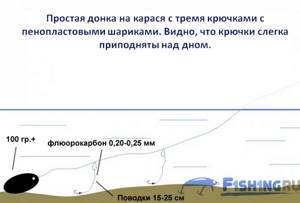
Anglers who fish in a well-known area can safely attach two leashes , but it’s definitely not worth it anymore - sterlet is a bottom-dwelling fish, there’s no point. The size of leashes needed is from 15 to 25 cm long and 0.20-0.25 mm thick . Choose the highest quality fishing line for leashes to avoid breakage, and also, cheap fishing line is prone to twisting, which will interfere with normal fishing. The optimal fishing line length is 150-200 meters. The feeder also performed well for carp fishing.
Ryobi Ecusima with size 3000 is suitable for catching small sterlet weighing up to 1.5 kg
When choosing a reel, pay attention to its free movement - this will make it easier to fish for sterlet. The fish do not particularly resist, especially the females after spawning, which makes fishing in the summer easy and enjoyable, because the bite at this time is observed around the clock. The reel size should be 3000-4000 for medium-sized sterlet.
fishing rod that is convenient for you, the main thing is that it is durable. The length is enough up to 2.5 m if you fish from a boat. When fishing from the shore, it will be more convenient to fish with a 4-6 meter rod. The position after casting will be correct in case of strong currents if you position the feeder vertically; In still water, keep it parallel to the shore.

The sinker must be heavy, at least 100 g , and sink instantly and hold the tackle in the current.
During a flood, sterlet usually stands in quiet backwaters and likes to feed near the border of fast currents and quiet water. This applies to the summer period. With the arrival of autumn, the sterlet begins to hide in deep-sea holes, moving away from the shores, so it prepares for wintering.
As a rule, during the day the sterlet likes to swim along the fairway, so when casting, take into account that the load flies about 20 meters.
Video on making bottom gear (tackle):
Tackle elastic band
Catching sterlet with an elastic band is very convenient if you plan to fish in one place for more than one day, and also if the bottom is smooth and clean. This method is simpler than fishing with a donk, because you don’t have to constantly get the gear out. You are allowed to attach no more than 5 hooks to an elastic band, but this is quite enough; you can pull out several sterlets at once.
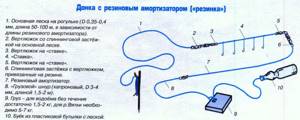
The first version of the donkey with an elastic band
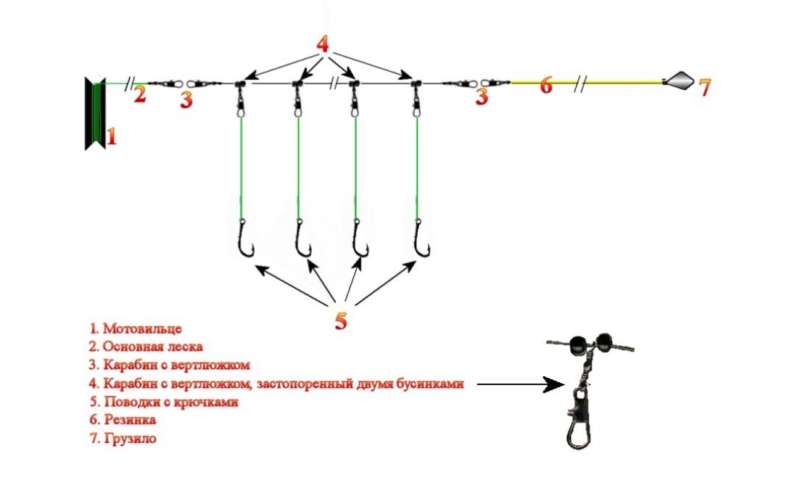
Second option with 4 leashes
For a five-meter fishing line you need 1 meter of elastic - this is how we calculate the tension coefficient. Take leashes for elastic bands from fluorocarbon measuring 0.2-0.23 and 15-25 cm . The load will show itself better in a wide shape, for example, in the form of a spoon or any geometric figure; it should lie flat on the bottom and not be carried away by the current. Weighing no more than 200 grams . and 15 cm . in diameter.
A complete article on making your own elastic bands.
How to choose hooks
When fishing with a donk, use a hook with a long shank No. 6; such a hook is more convenient to remove from a long mouth and you can place a large bait on the tip. If you prefer to fish with an elastic band, stock up on enough hooks, they get dull very quickly on the rocky bottom; or better yet, take a special sharpener for sharpening the hook - this will protect you from unwanted fish falling off the hook.
Hooks must be of high quality (take trusted companies, don’t skimp), it’s good if they unbend when hooked. If you take cheap ones, you will end up not doing sterlet fishing, but endlessly replacing gear. Opt for hooks without a beard, then you will be able to painlessly release the sturgeon back into the river if it turns out to be small.
How to increase your fish catch?
Over 7 years of active fishing, I have found dozens of ways to improve the bite. Here are the most effective ones:
- Bite activator . This pheromone additive attracts fish most strongly in cold and warm water. Discussion of the bite activator “Dry Blooder”.
- Increased gear sensitivity. Read the appropriate manuals for your specific type of gear.
- Pheromone -based lures .
How to catch sterlet
What kind of tackle does the sterlet bite on? This is a very interesting question that interests many novice fishermen. Therefore, it is worth considering the technique of catching sterlet using a donkey, a rod, a spinning rod and other gear. It will be important to familiarize yourself with how it bites on various equipment and which equipment is most suitable for catching sterlet.
Donk fishing technique
Donka is the main method of catching sterlet. Many fishermen note that this gear is more likely to catch a good catch of fish. This tackle should be used from the very beginning of the summer season; it is best to choose a donkey with rubber shock absorbers.
This method is highly effective because a large number of leashes are used - up to 5 pieces. When fishing with a donk, there is no spooking of fish.
What gear should you have:
- Coil. For donkey, a suitable option is an inertial type reel. Thanks to it, you can make long-distance casts. In addition, there will be no snags, and therefore fishing will be easy.
- Fishing line. The fishing line is suitable for any color, because the sterlet is not shy. Since it rarely jumps off the hooks, you should not pay special attention to the quality of the fishing line. A thin line with a thickness of about 0.30 mm is suitable.
- Leash. It is advisable to use a leash with a length of 20 to 40 mm. A permanent or removable leash will also work. The most suitable is a removable leash. It can be replaced with another if desired.
- Sinker. When choosing a sinker, you need to take into account the type of bottom and how overgrown it is. It is also worth taking into account the speed of the current. The optimal weight of the sinker is selected only through experiments.
- Hook. For sterlet, the most suitable hooks are No. 5 or 7. No more than 5 hooks should be installed on the bottom.
Fishing technique with a float rod
It may seem to many that catching sterlet with a fishing rod is a very uninteresting process, but with this equipment you can catch a large number of fish. Since this fish is of a calm nature, fishing with a fishing rod takes place without any resistance.
What gear should you have:
- Fishing line. Any type of fishing line can be used. But still, you should not buy a fishing line that is too thin, because it will be difficult to hook other gear onto it.
- The rod should be long and strong.
- The coil should be of the inertial type. It is with the help of it that you can make long casts.
- Hooks. Hooks should be small and thin. A maximum of 2 hooks are allowed on one fishing rod. The best option would be 1 hook.
- The leash should be chosen to be thin so that it does not get tangled with the fishing line.
It is recommended to use float gear to catch fish near the banks after the flood has subsided. At this time, she begins active hunting near coastal areas. Activity occurs during the daytime, so this is the right time to use float gear.
Spinning fishing technique
When the autumn cold sets in, the water in reservoirs begins to decrease. Therefore, the sterlet begins to go to greater depths. At this time, it lives in depressions, holes, where rivers merge. In these places it is recommended to fish with spinning tackle.
What gear should you have:
- It is best to use medium or large sized spinning rods
- The coil should be of the inertial type. It will provide a good casting distance and prevent snags, and fishing for fish will be easy.
- The fishing line comes in different colors. The diameter of the fishing line should be 0.25 to 0.35 mm.
- The leash should be used thinner than the fishing line. Suitable leash with diameter size 0.2 mm.
- The sinker is selected empirically. When choosing this gear, it is worth considering the type of bottom and its clutter.
- Hooks should be used with a long shank. The most suitable sizes are 5, 6, 7.
Other fishing methods
Nets are often used to fish for sterlet. However, they are only allowed to be used if there is a special license.
So, if fishing is planned with nets, the following recommendations must be followed:
- It is advisable to install the network in bottom places. It is desirable that the distance between the leads and the bottom surface be no more than 30 cm.
- Sometimes the leashes are lowered deep to the bottom places, and then, using “checkers”, the hooks are raised higher.
- Nets with checkered floats are used in reservoirs with high currents.
- The nets should be attached to the bottom using a special peg to prevent them from being carried away by the current.
- If the nets are installed on a rocky bottom, the hooks must be raised so that they do not come into contact with the stones.
What to use as bait
Although sterlet is not picky about food, it prefers live bait:
- Worm mounting options
Large worms;
- Insect larvae;
- Mayflies;
- Shrimp, crustaceans;
- Large fry (it should be mounted with a “stocking” or “ring”).
Sterlets are good at biting on pieces of spoiled fish and its entrails. The catch rate will increase if you add garlic to the main bait, because sterlet is very attracted to strong odors.
You can use artificial bait, but there is a prerequisite here - the bait should not be hard, otherwise do not count on any catch. Soft silicone nozzles with imitation of fish caviar have proven themselves to be excellent. And to enhance the effect, treat them with a special flavor; and choose these baits in red colors.
Catching sterlet in the upper reaches of the Oka. (Views: 1)
izigor
A new species of fish for me is the “sogblya”-biter, and also the main fish destroyers in our reservoirs. One of the articles of the Okhotnichaya Gazeta in 1929 https://okafish.ru/pages7/sterl.htm
The text of the article is “as is”, without corrections.
The rivers of the Oryol region are not distinguished by their abundance, especially since the main water artery, the Oka River, runs through the district in its upper reaches. In view of this, the amount of fish in the area has never been large and fish production did not and does not have commercial significance.
Even 60-75 years ago, when on the river. Oka had a significant number of ponds maintained for the needs of Oryol shipping (to raise the water level in the summer when barges were launched), ponds that were like cages and a feeding place for fish, the number of which was, one might say, relatively large, but now small - perch , pike, ruffe, roach, bream, gudgeon, chub, ide, sheresper, perch and “sogblya”-biter - this is an almost exhaustive list of fish from the upper reaches of the river. Okie.
The reasons for the decrease in the number of species of species and the weight of individual fish in the Oryol District (no more than 1-2 kilograms are caught) also lie in predatory fishing, which begins from the moment the rivers open and continues intensively until freeze-up. The main fish destroyers are children, who find only pleasure in catching fish.
The suppression of fish by bombs in the early years of the revolution greatly damaged the already weak population of our waters. Last year, the number of aquatic inhabitants in the river. The Oka has increased in size with a rare guest in our area - sterlet. Sterlet was registered near Orel only a hundred years ago - in the period 1825-1830, and then only as a rare occurrence. Since then, it has not been observed within the Oryol District. In 1908, the appearance of sterlet in the Oka River was noted by S. F. Shcherbakov, near Serpukhov (also as a rare phenomenon), but then it did not reach the limits of the Oryol District. This time the sterlet was discovered 70 kilometers from Orel, in the village. Karandakova, where the Oka is blocked by a mill dam - the only one along the entire length of the river from Orel to Nizhny Novgorod. For the first time, sterlet was caught on the 6th of June using a worm using a fishing rod. The caught sterlet was initially thrown away, since the local population doubted recognizing it as an edible, sharp-nosed, unprecedented fish. But soon knowledgeable people were found and the sterlet found use in the tables of the surrounding residents. Last year's catch included sterlet about four inches in size. This year, sterlet was caught up to seven inches in size, i.e. about 1 kilo in weight. It is clear that the sterlet has spent the winter. This is supported by the facts that in the river. Zusha (the first tributary of the Oka River) sterlet was caught in the hollow water last year near Mtsensk, it is caught now, and this spring and near Orel three pieces were caught on a fishing rod (which indicates that the obstacle created by the Karandakon dam, the sterlet was overcome in the hollow water). Of course, down the Oka River - outside the Oryol district - sterlet is available and caught (cases of capture have been recorded near the town of Beleva). The most significant catch of sterlet within the Oryol district was recorded this year near Karandakov, when 18 pieces were caught at a time.
Is life good for sterlets in Oka?
The arrival of special fish factory vehicles to the river is a non-trivial event. Bathers and other vacationers give up everything, even barbecue, just to see the miracle. The flow of water at breakneck speed carries confetti of small silver fish from the brought containers into the waters of the Oka.
Sterlet is a kind of symbol of Russian reservoirs. Although it belongs to the sturgeon family, it is a freshwater fish. Quite large - the average length is about 50 centimeters, and the weight is two kilograms. She is easily recognized by her long, elongated nose.
Since ancient times, sterlet has been and remains an object of fishing. So the population in reservoirs has greatly decreased - well, such a delicacy floats, why not catch it on a huge scale! Well, besides, this fish lives only in clean water. What the man didn’t catch, he poisoned. Where chemicals from factories and factories are released into the water, the sterlet does not remain. Why shouldn’t she respect herself, even though she’s a fish?
“In the Moscow region, it was almost lost due to the development of sand and gravel mixtures in river beds, due to overfishing, and due to environmental deterioration,” explained Andrey Romanov, head of the department for the reproduction of aquatic biological resources of the Mosrybvod Federal State Budgetary Institution. — It is much more difficult to restore a population than to lose it. Scientists have made calculations: about two percent of fish survive in the wild. From 50 thousand issued, this is only a thousand. Just don’t tell the specialists that this is not enough. They know how difficult it is even for these modest two percent.
This is a very high survival rate. Sterlet has no natural enemies in the Oka basin. Perhaps a person with his networks, but this is no longer natural, it is called something else. If a sufficient number of pebbles necessary for spawning are found or formed in the water, the sterlet will be able to reproduce.
Sturgeon produced by the Astrakhan and Volga fish factories have a much lower survival rate. This is due to the fact that the fish gradually slide into the Caspian Sea basin, changing fresh water to salt water and back. This transition does not have a beneficial effect. And our arrived sterlet will remain in Oka for permanent residence. And this makes it easier for her to reproduce.
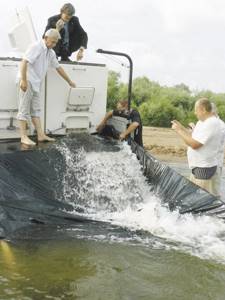
Bathers and other vacationers give up everything, even barbecue, just to see the miracle.
The Mozhaisk production and experimental fish factory is the only enterprise in the region that breeds sterlet fry on such a large scale. This year, 70,000 individuals were bred. Those 20 that did not end up in the waters of the Oka in the Serpukhov region were released into the Moscow River.
There were times when sterlet in the Oka River was almost extinct. Since 2001, juveniles have been released into reservoirs every summer.
“There is a possibility that the number of sterlet has already reached normal levels,” notes Andrei Romanov. - But to find out, it is necessary to conduct special studies. There is no funding for them, no interest from the authorities.
So now even scientists cannot say whether sterlet lives well in the Oka. But next year they will release the fry into the river again. Application for the next 50,000 has already been submitted.
What does sterlet bite on, and what to do with the caught fish?
In the reservoirs of the Moscow region, sterlet lives among sturgeons in natural conditions. In the Moscow region, sterlet inhabits the Oka, Osetra, and Moscow rivers. Occasionally found in the river. Klyazma, reservoirs of the canal named after. Moscow, Mozhaisk and Ivankovsky reservoirs.
The sterlet stands out among other sturgeons for its small size, as well as for the fact that it has significantly more than 50 lateral bugs (other species of this family, as a rule, have less than 50). The sterlet's antennae have characteristic fringes. It rarely reaches a mass of 5–6 kg, but usually no more than 1 kg. Its lifespan does not exceed 20–25 years.
In the first half of the 20th century. number of sterlet in the river The Oka was quite high; the species served as a commercial target. Since the late 1990s. a sharp reduction in numbers in the river was noted. Oka, primarily in the Lukhovitsky district, where the main stocks and spawning grounds of the species were previously concentrated; at the same time, the sterlet appeared and began to increase in number in the river basin. Moscow is higher than the capital, thanks to artificial breeding at the Mozhaisk production and experimental fish hatchery.
Sterlet is a typical river fish. It lives in small flocks on the current near the bottom, usually in deep places, on rocky or sandy soil. Small specimens are often found on sandbanks.
She spends the winter in pits, where she gathers in groups, falls into torpor and does not feed. In the spring, during the flood period, the sterlet rises up the river to breed. Spawning sites are usually located near wintering areas. Sterlet spawning grounds are of two types. The main spawning occurs on riverbed ridges of pebbles at a depth of 5–8 m; less often, it reproduces in rocky areas of the floodplain flooded with flood waters.
The optimal water temperature during the spawning period (usually late May - early June) is 12–17 °C. The development of sterlet eggs lasts about a week on average. After spawning, the sterlet is intensively fattened. Food is mainly provided by bottom organisms - aquatic insect larvae, worms, and mollusks.
Its most favorite food is mosquito and midge larvae. Sterlet readily eats the eggs of other fish. Sometimes, when there is a massive emergence of insects, the sterlet rises to the surface and grabs mayflies, stoneflies and caddisflies falling on the water. Large sterlet can occasionally swallow fish fry.
Meanwhile, reminds the Moscow-Oka territorial department of Rosrybolovstvo, sterlet is a valuable species of fish. Its fishing in water bodies of the Moscow region is prohibited. The fine will range from 2 to 5 thousand rubles, and if a sterlet is caught, you will also have to pay for damage, which will amount to 4,572 rubles per specimen. Therefore, if a fisherman accidentally catches a sterlet, it is better to release it.
The only exception will be fishing in a paid reservoir. You can see how to catch sturgeon on a fishing rod on our Youtube channel.
Sanskoye - Yushta
Spoon Fishing
One day, when the July Sun was melting the asphalt of Moscow streets, a huge party gathered. Everyone had the same goal - get out of the city, into the open spaces, closer to the water. A moment, and a caravan of four cars was already racing through the quiet morning Ryazanka towards the South-East towards Ryazan, the goal was Yushta.
Whether it was a long or short journey, our young pioneers Lyokha and Zhenya wanted to inspect the caravan from the outside. Take a look, so to speak. Having fallen behind, they noticed a strange subject with a trailer, which was brazenly dragging itself at the tail of the caravan. Chase! In order to drive away the annoying long guy, they roared with a huge exhaust pipe and rushed to overtake everyone. Speed, turn.
But the morning road was by no means so deserted. The red-blue lights and the howl of a siren that appeared from behind announced the opposite. A minute later, the crimson “pioneer” ten found itself pressed to the side of the road. The pioneers were extracted and invited for an edifying conversation and drawing up a protocol. Verdict - 138 km/h in a populated area!
A few minutes later, silent and dejected, without three haymakers in their pockets, the pioneers emerged from the belly of the police car. The conversation was a great success.
How many Heinekens could you buy with this money, how many Baltika No. 3? And the long guy, as it turned out, is not a subject at all, but an Eagle (Red Eagle). He stands with everyone else, smokes, and waits for the showdown to end. Eh, we missed.
We passed Ryazan. Another throw and we are there - the wide floodplain of the Oka, tall grass, colorful plants. No flies, no mosquitoes. Strange! What would we do without them? We set up cars, a camp - several tents and a gazebo tent. Evening gatherings will take place here. We inflated and lowered the boats, collected the gear.
The sun is blazing hot, there are no clouds in sight. It's 32 degrees in the shade - terrible! The mosquitoes must have dried up; soon it will be our turn to turn into mummies. Wind, where are you wind?! And then he appeared.
It was very bearable in the shade of the tent. The drinks are cool and there is plenty of food. We had breakfast. It's time to go to the water. Today we will catch fried fish for dinner. Trolling, of course. Oh yes. About refrigerators. A curious thing is a styrofoam box filled with beer cans. At the bottom of the box rest two frozen plastic water bottles. Cold beer for three days guaranteed! Cool water - five days!
Intelligence service. The places are gorgeous - pits are replaced by rifts, drains, and returns. There is so much to be found on the Oka River! The engine rumbles rhythmically - drill, drill, drill..r..r... The sun is blinding in full. The sides are painful to touch. Smak is already asleep on the bow, clutching the rod. Suddenly, having woken up, he begins to make suspicious speeches, like - let's catch Slavik with a jig. You will catch, and I will, like, watch and observe.
We stopped and anchored. Three casts and Smak, putting the tackle aside, started snoring more than ever. It’s clear - why bother with the jig! We caught several indistinct fish - asp, zander and pike. They let me go. But we looked at the places and found out something. It's time to go to base. Other crews - Komus, Orel and Sevos - have approximately the same picture. The largest pike perch is 1kg. For kwok - kukish with butter. Yearning. Although, what were we expecting in particular? June, July - don't care about fishing! But this is not about us. He who catches will catch.
Meanwhile, the hot July day gave way to a cool evening. It got dark and a brotherly dinner appeared on the table - cold vodka with cold Pioneer beer, round Ryazan tomatoes and all sorts of appetizers. Class! Everything is delicious, but I no longer have the strength. The eyelids seemed to have turned to stone. It's time to sleep.
Morning. The heat and the sun have already been turned on. I need to wake up, but I don’t want to. I wish I could get some more sleep. But it's time. However, everyone had already sailed away. Some go fishing, some go to the general store for beer.
Report from the boat:
Lyokha: - Hook! Bear: - No, not a catch. Look how the rod twitches! Lyokha turns off the engine and the boat begins to drift towards the fish... Lyokha: - It’s unhooked... Bear: - Look more carefully. This is a fish. At this moment, a pike head appears from the water with its mouth gaping. There is a wobbler in the mouth... Lyokha widened his eyes in fear and fell onto the bench: - What is this? The bear grabs the pike by the eyes and drags it over the side into the boat.
As it turned out later, the pike pulled 8 kg. The first Lekhina pike. Actually the first one.
Orel and Olga have several zander and pike. We have the same thing, only there are very few pike perch. Full flight to the jig. But there is also night twitching! In the evening, the battalion commander fried pike and pike perch. He knows how to do this. We had dinner and drinks. We also had dinner. We also drank. And the scoundrel Smak, pissed off in his chair, said: “Slavik, what the hell with this twitching of yours!” And then he poured it out for everyone. What to do? I had to swim alone in pitch darkness with a flashlight on my forehead.
Anchored. First cast and gristle! Something flashed overhead - it was my jig spinning rod plunging into the water. How could I hook him? My stomach felt cold, my legs felt weak.
Drowned, damn it! Although the depth is small, in such a current what falls is lost. I wound the reel - there is something. Heaviness. Faint hope. And...oh miracle! A tulip appears from the water, a ring, a second ring. This is my spinning rod! Grabbing the tulip carefully, I pull out the recessed CD-Rods with a Caldia KIX reel. I sat and worried. Let go. And really, what the hell with this nightly twitching!
The next day it became even hotter. The wind changed and blew from the shore. Everyone who was on the shore fell into the water. The bite was already indistinct and completely dried up. But the fishing gods are known to love surprises. So it is this time. In the evening we decided to place larger bets. I put on the green striped bomber B25 , Smak - bomber BD7 and went along the pit. We didn’t even have time to walk two hundred meters when a powerful bite happened. Catfish! He pulled it, tore it to the side, and the cartoon gave up the cord. Smak climbed onto the bow of the boat, grabbed the camera and pretended to be a cameraman.
It got dark quickly, but the catfish still didn’t give up. At first it seemed that he weighed ten. After ten minutes of struggle - twenty.
Here he appeared on the surface, and again went into the depths. As time went. Putting down the video camera, Smak took up the camera - now he is a photographer. It is clear that he is clearly not going to help. If Smak were an insect. That would be nice. With one hand he makes a video, with the other he takes a photo, with the third he gives the glove, with the fourth he grabs the catfish. Yeah, dreams.
We pulled out the catfish and filmed everything we could. They weighed it and rejoiced. The catfish pulled 18.5 kg. Fishing Fortune is fickle. But this time she played on our team. If not in attack, then she was definitely on goal.
The next day everyone felt tired and sailed to a sandy island to swim, sunbathe and drink beer. In short, decompose. The eagle volunteered to fry the pike perch in batter, and the bear swam away to squat. We started belated, lazy trolling. At 11:00 the bite started. First one small pike, then the second a little larger, the third, the fourth. The gusto placed some kind of long liberty and lured a good specimen. We swam, swam some more. The bite is gone.
At lunchtime everyone gathered under the fraternal roof of the tent. The pike perch in batter was magical. The older generation still knows how to cook. Loves this business. Not so the growing pioneers. Having landed on the shore and, like locusts, grabbing everything that was on the table, the pioneers jumped into the boat and whack. Gone! The beer must have run out.
In the evening we turned on the perch. Small, but a lot. He grabbed everything. But where there is perch, there are other fish. Exiting from six meters to two and a half is another topic.
Suddenly grab it! And there are bigger fish on the hook. One and a half kilo sterlet. Fortune is on our side again! But rules are rules. I had to let go. Smak almost burst into tears, remembering the taste of smoked autumn sterlet, which he cracked with vodka last year. Nostalgia. By the way, yesterday’s catfish had escaped by that time. He hung, hung on a rope and escaped. They apparently cut the rope with a screw.
Orel and Olga bomb pike perch using a hardcore LB90. It turns out... It got dark. It turned out even better. Night trolling is mysterious! Anything can happen.
Last day. I didn’t want to fish; I needed to get some sleep before going on the road. The barometer was falling and information was received that there was rain and hail in Ryazan. So it will soon reach us. We gathered slowly. Before a thunderstorm, the steam room is such that it seems like there is no air left at all. Gradually the sky darkened. Here are the first, rare drops of rain. It's time to head back. Fishing on the Oka is over.
But we will return to these fertile lands. We will definitely return.

Happiness exists, it cannot but exist. Isn't it true?
20.07.2009
<< Back
How and what to catch sterlet
10 minutes Author: Irina Chernikova 0
Sterlet is famous for its taste, and therefore, probably, there is no fisherman who would not dream of catching this tasty fish. However, a novice sterlet hunter should know not only the intricacies of fishing for this fish, but also the laws that regulate fishing.
This fish is found in various regions of Russia. In this article we will talk about what to catch sterlet with, where to catch it, and most importantly, how to do it in such a way that there are no problems with the law.
Where to fish?
The rivers of the Urals and Siberia were once famous for the abundance of sterlet, but ecology has done its dirty work, and now this fish is listed in the Red Book of Russia. The rules of amateur fishing prescribe how to deal with accidentally caught fish of this species in the following way: it must be carefully, without causing injury, removed from the hook and released back into its native element. The fine for catching a fish, if it is not released back into the river, reaches 12 thousand rubles per head. If the fish is caught using poaching gear, then there will be even more problems with the law. Is it worth the risk?
A sterlet was released in the Serpukhov region in Oka
Last week, more than 44 thousand individuals of sterlet were released in Oka near the village of Lukyanovo, Serpukhov district. The event was organized by employees of the Moscow-Oka Territorial Administration of the Federal Fisheries Agency
Last week, more than 44 thousand individuals of sterlet were released in Oka near the village of Lukyanovo, Serpukhov district. The event was organized by employees of the Moscow-Oka Territorial Administration of the Federal Fisheries Agency and the Federal State Unitary Enterprise Aleksinsky Chemical Plant. The so-called stocking of fish is carried out annually in order to compensate for the damage caused to the river by human activity.
The sterlet was grown in the fish breeding and rearing workshop of the Aleksinsky chemical plant in the Tula region - the only nursery in the Russian Federation where there are all types of sturgeon. The Oka sterlet broodstock is used to restore the population of this fish in the Oka River. Over ten years of work, two million fry were released into the river. The survival rate of fish is almost one hundred percent. And if earlier the species was on the verge of extinction, now the sterlet is gradually restoring its population size.
The fish farm currently has ten species of sturgeon: beluga, sterlet, sturgeon (Russian, Siberian, Lena, Baikal, Italian), sturgeon, Aral thorn, American paddlefish.. Of these, three are listed in the Red Book - Azov beluga, Baikal sturgeon and Aral thorn. 15 tons of commercial fish and 150 kg of caviar are produced here per year.
In the process of artificial incubation of sterlet eggs at the plant, a 90% survival rate of fish was achieved. In nature, at best, 1 out of 100% survives. Juvenile sterlet are released into the Oka River in the summer, when the fry of different sizes reach a weight of approximately five grams. There are 5 specimens of albino belugas in the workshop; this fish is practically never found in nature. Cases of capture of albino specimens are known to occur once every few decades. Albino beluga caviar is not black, but bright yellow. It's called "almas". The cost of such caviar on the international market is 20-30 thousand dollars per kilogram.
What to “treat?”
If you go back to the roots and read directly about what kind of fish sterlet is (you can read it here), you can understand that it prefers various insects as food: mayfly, caddisfly, various small crustaceans, mosquitoes, worms. From all this the following conclusions suggest themselves:
- The sterlet is, in principle, omnivorous, but more often bites on animal baits.
- The preferences of individuals depend on their age: young sterlets like to feast on small crustaceans (mormysh, amphipod), adults prefer worms. In regions where there is a large mayfly population, the sterlet feeds on it for the main period of time: on the Irtysh, Ob, Sura and other large rivers, the mayfly stays on the surface of the water for half the summer.
- Depending on the time of year, the taste preferences of fish change from smaller food in early summer to large baits closer to autumn. This is due to such a natural phenomenon that absolutely all animals and fish are susceptible to, such as the accumulation of useful substances before the winter period.
- It is unofficially believed that the best bait for sterlet is a dendrobene worm. Moreover, the larger the bait itself, the more trophy a specimen can be caught using it.
When to catch and where to look?
Sterlet fishing is common throughout Russia. Despite the fact that the difference in fishing tricks in our country is very great, with sterlet everything is simple: you can catch it only with a float rod or donka. Any fisherman who knows how to handle these tackles can catch a king fish. You just need to know small secrets, which we will tell you about below.
Licenses to catch sterlet begin to be issued only after all the fish have spawned. The female who lays eggs loses a lot of strength and needs a lot of time to restore her vital energy. During this period, the female usually stays in shallow water, where food is easy to find.
Armed with an echo sounder or a marker rod with a float, you can determine the place where the underwater hole ends and the sandbank begins; it is this point, or points, that will become the best place for catching sterlet at the beginning of the summer season. Keep in mind that the spawned sterlet is extremely hungry, so it is in search of food almost around the clock. She bites both at night and during the day.
When the fish goes through a recovery period, it returns to its usual habitats on the river: various holes, which are often located at a great distance from the shore. She becomes more cautious and timid. In the middle of the open water season, it is better to catch sterlet at night. Moreover, the fisherman must behave as quietly as possible on the shore or while in the boat. It is important for the sterlet that nothing disturbs it.
Where and when to catch sterlet
Seasonal fishing features:
- Sterlet fishing in spring begins relatively early, usually in March. Sterlet fishing in March is still unstable, it may be caught in the catch or completely absent, as it is not yet very predictable. The best time for spring fishing is after spawning, when the fish eat off to compensate for the effort expended. After the water level drops, the sterlet swims to the lower reaches of the reservoirs, and only “local” fish remain in their areas, spawning and living in one place;
- In summer it is good to catch using donks. When a reservoir is filled with water, it is often found at a distance of about 30 m from the shoreline. Now it is caught throughout the day, but the greatest activity is observed at night. In the morning, afternoon and evening, activity is approximately the same, falling slightly;
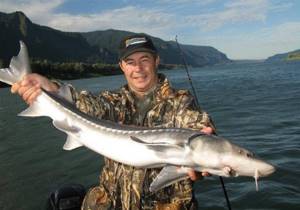
Relatively early, most often in March, sterlet fishing begins
- in autumn it is caught almost until the end of the season. The method of catching does not differ from summer time, but the sterlet prefers to descend to greater depths in preparation for winter. It is often found at the exits of pits, and when one individual is found, there is a high probability of a large catch. It is better to catch at a distance of 60-70 m from the shore;
- Catching sterlet in winter usually does not bring results, although sometimes relatively active individuals are caught. This is most likely due to the warm winter. There is no point in counting on a good catch now.
Fishing supervision often prohibits fishing at night due to its high activity; in some regions fishing is allowed exclusively during daylight hours.
In order for sterlet fishing on the river to be as successful as possible, the angler is required to know the fish’s habitat preferences.
Places for catching sterlet:
- swims exclusively on rivers with clean, oxygen-enriched water. It is extremely rare in places with stagnant water;
- most often lives in deep-sea holes or ditches;
- usually swims in places with a hard bottom. Almost undetectable on muddy bottoms;
- often found at the entrance and exit from depth;
- prefers a bottom with flooded snags;
- At night it leaves its habitat, swims out into shallow water, and now float gear is often used.
Methods of catching sterlet
Since the sterlet’s favorite bait is a worm, gear that can be used to deliver the bait directly to the place where a school of fish is hiding is suitable for catching this fish.
Fishing with a float
In the post-spawning period, sterlet is often caught using a float rod. The behavior of females during this period is extremely risky; they come close to the shore, which means sending bait “under their nose” will not be difficult. The sterlet bites greedily, swallowing the hook very deeply, so do not leave the fishing rod unattended, and also always have on hand a device for removing the hook from the fish’s mouth - a forceps.
It is most interesting to catch sterlet on a fishing rod provided that the bites are not interrupted by other fish.
Fishing on small rivers
Where the width of the river allows, a rig called a tug is widely used. If described schematically, fishing occurs as follows: two fishermen are located on opposite banks, between them there is a stretched line with attached hooks and sinkers. Fishermen move in one direction, while the equipment glides along the water surface. Such a shallow supply of bait is good for the end of May, beginning of June, when the sterlet is recovering from spawning. Both the sliding technique and simply dipping the baits into the water are used. According to the idea, the fish will confuse where the floating insects are and where the fisherman’s bait is, and thus will peck without fear.
If a fisherman hunts sturgeon alone, he can build a trap with his own hands. To do this, you need to replace the second assistant with a regular stake, that is, tie a fishing line on the opposite bank. It is best to make a connection in the form of a strong elastic band between the fastening support and the fishing line. They are connected by any of the fishing knots. The function of the elastic is to absorb the jerks of the fish, in case a good fish is caught on the tackle.
A similar type of equipment is a saddle. Nets are called gear that consists of two fastening stakes and a fishing line with leashes with hooks often tied to it. Such equipment, of course, can be effective when hungry fish are rushing around in shallow water. However, according to fishing rules, this type of fishing is prohibited. In the end, this is not sporting, but is aimed directly at the commercial catch of fish, which is often caught not by grasping a hook with the mouth, but by grasping various parts of the body. Although, this equipment has been around for many years, and those who care not about the process, but about the result, use it.
Using bottom gear
If you watch a video of how sterlet is caught in different parts of our Motherland, you will see that the gear for catching sterlet is very different, but bottom gear occupies a leading position in this list. Let's look at each of the subspecies of bottom fishing.
A tip for sterlet is no different from the standard old-fashioned tip for any other fish. One end of the fishing line is equipped with a heavy sinker, the weight of which can be calculated taking into account the following parameters:
- Reservoir depth
- Current speed
- Bait and hook weight
- Scaffolding thickness
A hook or several of them are fixed at the end of the hook, and any bait used for catching sturgeon and sterlet is placed on them. Hooks with a sinker are sent into the water as soon as the load touches the bottom, the free end of the fishing line is secured to a poke, and a small stick is fixed to the stretched fishing line to monitor the bites. At the moment of a bite, it will begin to vibrate and rotate.
Catching sterlet with a donk, of course, is much more interesting than using ordinary hooks, and is also more effective. Firstly, powerful spinning and even carp rods are used to equip the donkey. A bite can not only be seen, but also heard by the characteristic ringing of the bite alarm that is equipped with the rod. Secondly, even if there is no school of fish in the place you have chosen, you can lure sterlet; you can and should fix a feeder on the bottom.
Choosing a place for bottom fishing for sterlet is not an easy task. You should navigate only by your own observations of the bottom topography, or by echo sounder data. To find the location of this fish, you need to find a deep hole, at the exit of which there will be a sharp shoal, and a rocky or sandy bottom. It is sand that is the main element of the underwater world, which shows that sterlet can live here. Driftwood and underwater vegetation will only turn away the sterlet; it is not a fan of such places, and only enters them in the spring.
After you have decided on the choice of location, you need to prepare bait for the sterlet. Making it couldn’t be easier: you just need to cut the worm that you put on the hook into small pieces and mix it with the soil that is at the bottom of the reservoir. To do this, just scoop up some water along with sand. The most convenient way to cut a worm is with a special tool that sharply cuts the body of the worm without crushing it.
Sterlet fishing area
The choice of location is decisive. A good place is worth a lot.
From year to year, fishermen go to the same places and most often return with a catch. These places occur both on the main river and on narrower through channels (sleeves), but always with a current.
Depending on the time of year and water level, the sterlet’s habitat and feeding habits change significantly. Good places are passed down by inheritance, sold, and there are even “wars” for some good places.
There is no specific and clear definition of where to catch sterlet on the river. Depending on certain conditions (water level, weather, time of day, etc.), sterlet can be caught in completely different places. On an unfamiliar body of water, it is most reliable to land at the end of the hole and, accordingly, at the beginning of a long shallow. Without leaving one place, you can fish both the pit and the exit from the pit and the shallows.
Sterlet changes its feeding places up to several times a day. Sterlet is one of those fish that can be caught around the clock. Since fishing for sterlet at night is prohibited, we will analyze fishing at another time. It must be said right away that even in the daytime (morning, afternoon, evening) you can fish almost no worse than at night. Although at night, the sterlet bite will be better.
In deep water, sterlet enters quiet-water coves, but it is impossible to catch it there with amateur gear. And although it enters places without a current, it always stays close to the current.
Therefore, here’s another tip: look for the mouths of streams or the boundary between current and standing water. It is precisely along the border of fast and stagnant water that the sterlet looks for food.
These places are especially relevant at the beginning of summer. Further towards the autumn, the sterlet more and more often goes to the pits, and in the fall it almost stays only on them.
If you fish in holes, then there are two options worth trying: fishing in holes close to the shore (sometimes the bite happens literally 10 meters from the shore) or directly in the hole. Most often during the day, the sterlet stays either in holes or walks along the fairway.
It is not difficult to determine the fairway - it can be seen by the location of the strongest flow of water on the river. When casting onto the fairway, use not only a heavy sinker, but also cast 10-20 meters further than the fairway. When the rig is lowered to the bottom and drifts slightly, the sinker will eventually land exactly on the fairway.
Sometimes, especially in the morning, sterlet comes out to feed on the shallows and there you can also catch it, but with the longest cast possible. In the shallows, sterlet usually does not come close to the shore, and its feeding areas begin at 50 meters, and more often at 70-100 meters.
There is another way to determine where the sterlet is feeding - visually or by ear. What does it mean? Often sterlet “melts” or makes “candles”.
Its splashes cannot be confused with any other fish. Firstly, these splashes occur quite far from the shore or on the fairway, and secondly, the sterlet does not “hoot” or beat its tail, but splashes.
Obviously, at high speed it rises vertically upward behind the floating food and jumps out of the water, and since its weight is small, it falls into the water with a sound similar to the sound of a small stick falling into the water.
As you can see, there are a lot of places to catch sterlet and you still need to look for a cool spot. Usually, local residents clearly know where it is best to look for sterlet at a certain water level. If you find yourself at a sterlet exit site, you can start getting bites literally in the very first minutes. There is no point in sitting in one place for more than an hour and waiting for a bite.
Three or four of us often came to catch sterlet and each of us had several catches. We began to place our battery at intervals of 50 meters and they occupied all possible places: the pit, the exit from the pit, the beginning of the sands (usually with a clay or muddy bottom) and the sands themselves. And from this string of gear it was clearly visible where the fish was currently holding.
Here's what you need to know: Fishing times
Most often, sterlet was caught only in the hole in the early evening; closer to sunset, bites began at the exit from the hole, but early in the morning or at dawn it was well caught on the sands. We knew these features and therefore did not remove the baits from the sands, although there were no bites in the evening, but there was a sure expectation that they would be caught at night or in the morning.
Often I had to find myself in places with a lot of ruffs. Of course, they greatly interfere with fishing, but nothing can be done - you need to be patient and bring more bait with you. I can say one thing for sure: ruffes are the same fish as any other, and from time to time they also stop biting.
Catching sterlet
Sterlet is rightfully considered one of the most delicious fish in Russian waters, which is why it is so popular among fishermen. In addition to its gastronomic qualities, scallop has another unique property, namely, it does not have parasites. It is not afraid of even such a common disease among fish as opistrochiasis, therefore, catching chechuga is a priority among many fishermen.
Sterlet belongs to the sturgeon family. Red fish is also about chechug, but not only. Although, the very concept of red fish is a very conditional concept, because it is called so not so much for its color as for the quality of its meat. Something like “blue blood” when compared to a person. And black sterlet caviar is simply a delicacy!
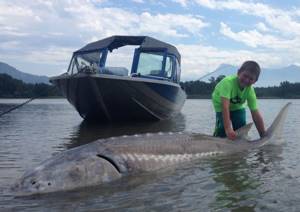
Sterlet habitat
Most often, chechugum can be found in northern and middle latitudes. Sterlet is a marine fish, but it spawns, as a rule, in rivers that flow out (or flow in) from these seas. You can meet it in the following seas:
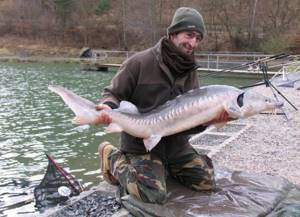
Chickfish are also often found in rivers, as mentioned above. Sometimes they are also called “sterlet rivers”. Here are the main rivers where it is found, or at least occasionally, in places, it comes across:
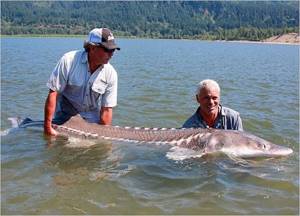
Below in the article we will look at catching this fish on some rivers, and various methods of such fishing.
Catching sterlet on the Oka River
Catching sterlet, about which there are a lot of videos and articles on the Internet, is a very interesting, and for some, profitable activity. But we will not consider “profitable” options here - this is for poachers, but let’s talk about fishing “for the soul.”
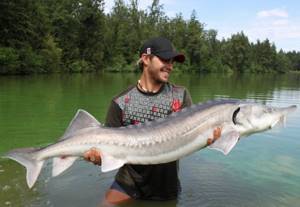
Catching sterlet on the Oka River is a very difficult task, especially considering that the population of this fish there is very small. At the moment, they are only trying to restore the salmon population there, so sterlet fishing there is rather of a sporting nature.
Nevertheless, it is not officially prohibited to catch it there - you can safely put specimens over 40 centimeters in size in your boat. Or you need to purchase a license to catch salmon, albeit in limited quantities, since the population of this fish in Russia, and especially in the Oka, is very low, although there is a certain increase at the moment.

Catching sterlet with a fishing rod
From the point of view of sport fishing, catching this fish with a fishing rod is probably not very interesting, but the effect of this method is very high. This is a very calm type of fish; during the fishing process, resistance on its part is not felt at all. It is quite easy to catch it with a fishing rod.
Everything again comes down to finding a place where the sterlet feeds.
Gear requirements
You can use any fishing line; you don’t need to take a very thin one, because other types of equipment will be quite difficult to hook onto it. The rod should have an inertial reel so that it is possible to accurately cast the tackle and quickly pull it out. Many people use spinning rods, which makes this much easier. In addition, with its help you get rid of an increased number of hooks, because at most you can use only a couple of hooks, and usually there is only one. Various “sediments” - small debris and river vegetation - also annoy the fisherman less.
The fishing line and leash are taken thinner, but not less than 0.2 millimeters, so that, thanks to its elastic qualities, the main fishing line does not get tangled with the leashes.
The most popular bait when fishing with a fishing rod is an earthworm of the appropriate size. Some people use a method called “triple bait”, where they bait the main worm and then attach a couple more maggots.
Sometimes fry serve as bait, but in this case predators such as pike, perch or pike perch can actively peck.
How to catch
It is quite good to catch sterlet with a fishing rod near the banks when the flood has finally subsided. At this time, schools of fish feed near the shore. Fish are most active during the daytime; this is the time that is considered ideal when using a fishing rod.
Catching sterlet on the Ob River
On the Ob, sterlet is found quite often, at least more often than on the Oka. Therefore, catching chechug on the Ob River is quite popular. Most of all, she prefers the riverbed, especially during spawning. Sterlet, as a rule, rarely swims alone, but mostly travels in a flock.
In the summer on the Ob it moves only downstream, but in winter it hides in deep-sea holes. In winter, the salmon eats very little, so it is eaten off in the summer. It is very difficult to catch it during floods and floods, since it has much more room for maneuver.
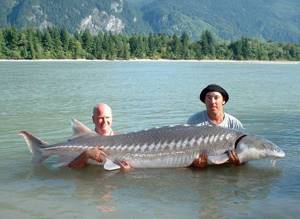
When to catch sterlet on the Oka - fishing for sterlet: where and what to catch. tackles and methods of catching sterlet
But if we generalize, it turns out that the more water and the warmer the weather, the closer to the shore the sterlet stays and is caught. In June, July, early August it can sometimes be caught literally meters from the shore. As the water level drops, the sterlet moves further and further from the shallows to the holes. And already in the fall it stays mainly only in pits.
How to catch sterlet? Tackle and fishing methods
Please also take into account that as the water level drops, the sterlet ends its post-spawning feeding period, and its migratory form is migratory and the local form of sterlet begins to migrate to the lower reaches of the rivers. Gradually, only local sedentary herds of sterlet remain in the upper reaches of the rivers. The further downstream you go, the more and more sterlet there will be.
And since our Siberian rivers all flow north, it turns out that the further north you go, the more sterlet there are. By winter, the sterlet finally determines its wintering place and leaves all small tributaries, only into large rivers. Accordingly, the larger the river, the more likely and more often there are wintering pits with a depth of 20 meters or more, on which eventually, somewhere in early December, sterlets begin to nest. But this process cannot be fully called hibernation. Although much less common, sterlet is still caught in the net in winter.
Methods of catching sterlet
And sterlets are caught directly in wintering pits and around them all winter, and even quite well. At this time, she eats almost nothing - she is caught only with nets or by poachers. Although, it must be assumed, the winter sleep of the sterlet is different from the hibernation of other red fish. The standard Siberian bait is a worm. Not necessarily big, I fish with both earthen and dung ones. I prefer medium-sized worms. I dress them entirely, but not with stockings, but pierce them in several places. This keeps the worm tighter on the hook. The sterlet feeds almost like a carp; most often it swims near the bottom and sucks up food from below with its mouth.
The sterlet's mouth is large and even very large pieces can fit into it. Sterlet is often caught using large crawling worms, pieces of fish or offal. Discounts for Club members! Problems and Suggestions for the forum. Problems and Suggestions for www. But in the middle of summer, the fish swim to longer distances from the shore and therefore it is necessary to use a more powerful spinning rod, for example, a carp spinning rod. It is very important that the bottom gear is in the place of the word. In this case, the fisherman must take into account its possible drift by the river current. This is due to the fact that sterlet is not very sensitive to pain and does not resist, unlike many other fish. Experienced fishermen know that sterlet is quite unpretentious in choosing bait. You can use a dung worm or an earthworm. Various combinations of baits have also proven their effectiveness. Some combinations are focused on achieving a strong odor. Choosing a motor and boat. How to make a stuffed pike. About zherlitsy and circles. Most of all, she prefers the riverbed, especially during spawning. Sterlet, as a rule, rarely swims alone, but mostly travels in a flock. In the summer on the Ob it moves only downstream, but in winter it hides in deep-sea holes. It is very difficult to catch it during floods and floods, since it has much more room for maneuver. Many fishermen believe that the donka, also known as zakidushka, is probably the best tackle for catching sterlet. Let's consider one of the fishing methods - fishing with a donk. It is best to catch sterlet with a donkey after spawning. Very rarely does a fisherman come across single specimens.
It is often found in fresh water bodies, but only stays in one place in winter. The rest of the time, fishing for sterlet can be somewhat difficult due to the fish’s habit of constantly wandering. With the onset of spring, this representative of the sturgeon rushes to places where the water is warm. Often these are the upper reaches of rivers. In the summer, the fish begins to slowly move downstream, gradually approaching the wintering place. Fishing for sterlet in large rivers during this period can be very productive. The fish feed intensively, since in winter they eat almost nothing. In general, fishing for sterlet in Altai and in the Northern Dvina River basin can result in the capture of a trophy specimen weighing up to thirty to thirty-two kilograms. At this time, sterlet fishing is carried out only at great depths. In winter, the fish chooses remote corners in the lower reaches of reservoirs, sometimes descending to a depth of twenty-five meters. During this period it is very difficult to catch it on a hook, so anglers must know what to fish for. OVERNIGHT FISHING ON CATFISH! In this film I hike on the rocks and admire the views of nature. Along the way, I collect dandelion roots and wild mint. The menu for the hike includes crumpets, scrambled eggs and dandelion root tea with mint.
Sanskoye - Yushta
Enjoy watching and thanks for your attention! Water transport rights. Full support of the client until receiving the certificate in hand. Attendance at the exam is mandatory. Exams are held at the Yauz reservoir. Mobile version Ad API Help License Agreement News Vacancies About the company.
In order to tag a person, hover over his photo and press left mouse button Left-click on a photo to tag people in it. Sterlet fishing has been practiced since ancient times. And there is nothing reprehensible in this fishing action. After all, sterlet, like other representatives of the aquatic world, is valued for its tasty meat and the ease of its preparation. But the peculiarity is that this type of fish is not afraid of opisthorchiasis. Perhaps this is the main reason for the increased demand for sterlet fishing. In addition, the fish have adapted to the conditions of many reservoirs where there are no indicators of pollution. Its numbers are gradually beginning to increase, but it is difficult to catch large specimens using various types of gear. Peculiarities of catching sterlet Sterlet is characterized by a social way of life. At all times of the year, anglers rarely come across single specimens. It is worth noting that the fish often lives in fresh water and stays in one place only in winter. In other periods, she prefers to wander. From the beginning of spring until late autumn, the sterlet chooses places with warm water to live and rushes to the upper reaches of the river. Therefore, fishing must be done from deep layers of water. Sukhov Andrey, June 6 Shiroganov Oleg, June 6 No way before, I’ll be on the Prony and Oka spit, invited. Tereshchenko Ilya, June 5 Kuznetsov Alexander, June 6 You gut the very first measured sterlet, cut off the head, cut off the thorns according to Soloviev Mikhail, June 7 Tereshchenko Ilya, June 7 Solovyov Mikhail, June 8 Tereshchenko Ilya, June 8 I think you have Volgar, March 7 Volgar, June 21 Volgar, June 22 Mikhail Soloviev, June 22 Tell me about your miracle method! Interested to hear what and how? And what kind of misfortune is this?! And life is good and living is good! How I love to experiment! Finally got out into nature! And many more times Hurray! This lake is also home to perch. Rest only in our dreams! Main sections Places Forums Databases Reports Videos. Recipes Competitions Directory Photos Users. Reservation of a base for fishing Bases for hunting Reservation of a base For the owner of the base. Info About the project Fishing and hunting in Russia Contact information User agreement For advertisers. When using site materials, a link to the original source is required! Select the part of the picture that will be displayed. Move the area with the mouse, change the size by dragging the corners of the selected part. The embed code for the blog will look like this:. At this time, she begins active hunting near coastal areas.
Activity occurs during the daytime, so this is the right time to use float gear. When the autumn cold sets in, the water in reservoirs begins to decrease. Therefore, the sterlet begins to go to greater depths. At this time, it lives in depressions, holes, where rivers merge. In these places it is recommended to fish with spinning tackle. Nets are often used to fish for sterlet.
school-leaders.ru

